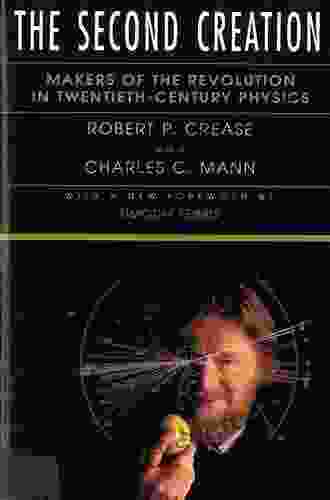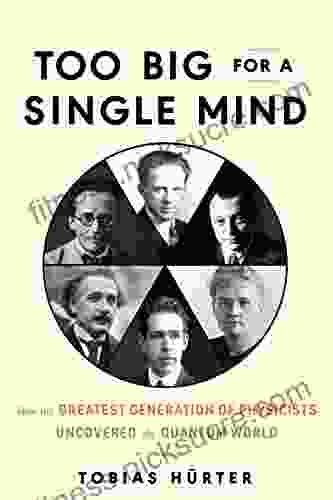Makers of the Revolution in Twentieth Century Physics

The twentieth century witnessed an unprecedented explosion of scientific discovery, particularly in the field of physics. A group of brilliant minds, driven by an insatiable curiosity and an unyielding determination to unravel the mysteries of the universe, stood at the forefront of this intellectual revolution. Their groundbreaking discoveries not only transformed our understanding of the world but also paved the way for countless technological advancements that have shaped modern society.
4.3 out of 5
| Language | : | English |
| File size | : | 2881 KB |
| Text-to-Speech | : | Enabled |
| Screen Reader | : | Supported |
| Enhanced typesetting | : | Enabled |
| Word Wise | : | Enabled |
| Print length | : | 500 pages |
In this article, we will delve into the lives and extraordinary achievements of some of the most influential physicists of the twentieth century. We will explore their humble beginnings, scientific breakthroughs, and the lasting impact of their work on our world.
Albert Einstein (1879-1955): The Father of Modern Physics
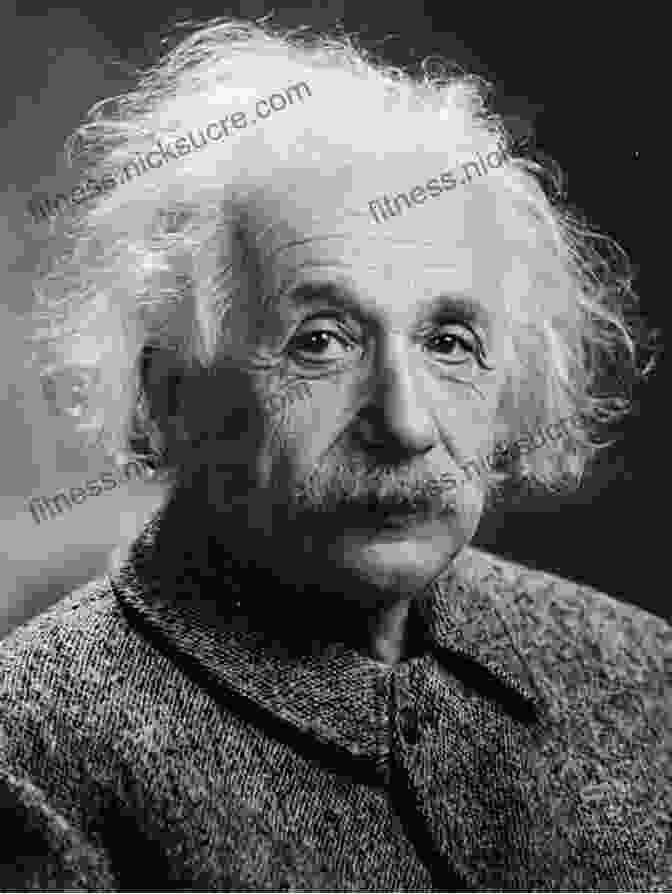
Albert Einstein is widely regarded as the greatest physicist of all time. His groundbreaking theories, including the theory of relativity and the theory of quantum mechanics, revolutionized our understanding of space, time, and the fundamental nature of the universe. Einstein's work laid the foundation for countless scientific and technological advancements, including the development of nuclear energy, lasers, and the internet.
Einstein was born in Ulm, Germany, in 1879. His early education was unremarkable, but he showed an early aptitude for mathematics and physics. After graduating from the Polytechnic Institute in Zurich, Einstein worked as a patent examiner in Bern, Switzerland. It was during this time that he published his seminal papers on the photoelectric effect, Brownian motion, and special relativity.
In 1915, Einstein published his general theory of relativity, which revolutionized our understanding of gravity and the structure of the universe. Einstein's theories were initially met with skepticism, but they were eventually confirmed by a series of experimental tests. Einstein's work earned him the Nobel Prize in Physics in 1921.
Einstein remained active in research and teaching throughout his life. He held positions at the University of Zurich, the University of Prague, the University of Berlin, and the Institute for Advanced Study in Princeton, New Jersey. Einstein died in Princeton in 1955.
Marie Curie (1867-1934): The Pioneer of Nuclear Physics
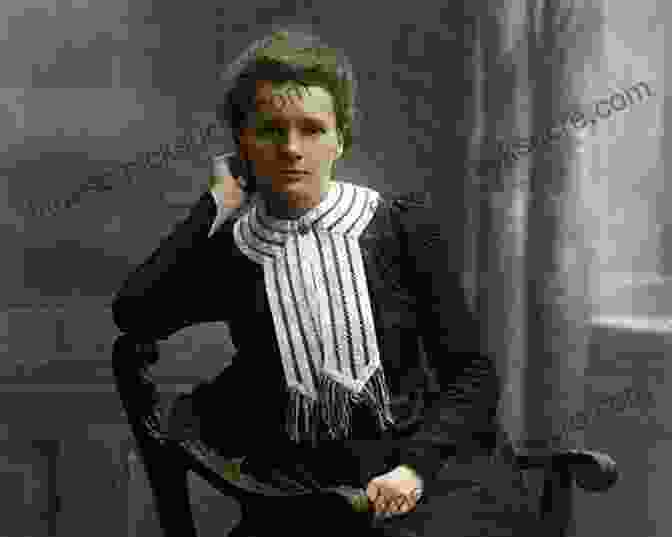
Marie Curie was a Polish-French physicist and chemist who conducted pioneering research on radioactivity. She was the first woman to win a Nobel Prize, and the only person to win Nobel Prizes in two different scientific fields.
Curie was born in Warsaw, Poland, in 1867. She studied physics and mathematics at the Sorbonne in Paris, where she met her husband, Pierre Curie. Together, they discovered the elements polonium and radium. Curie's work on radioactivity earned her the Nobel Prize in Physics in 1903, which she shared with her husband and Henri Becquerel.
After Pierre Curie's death in 1906, Marie Curie continued her research on radioactivity. She became the first director of the Curie Institute in Paris, which she founded in 1914. Curie's work on radioactivity led to the development of new medical treatments for cancer and other diseases.
Curie died in 1934 from aplastic anemia, a disease caused by exposure to radiation. She is buried in the Pantheon in Paris, alongside her husband.
Niels Bohr (1885-1962): The Father of Quantum Mechanics
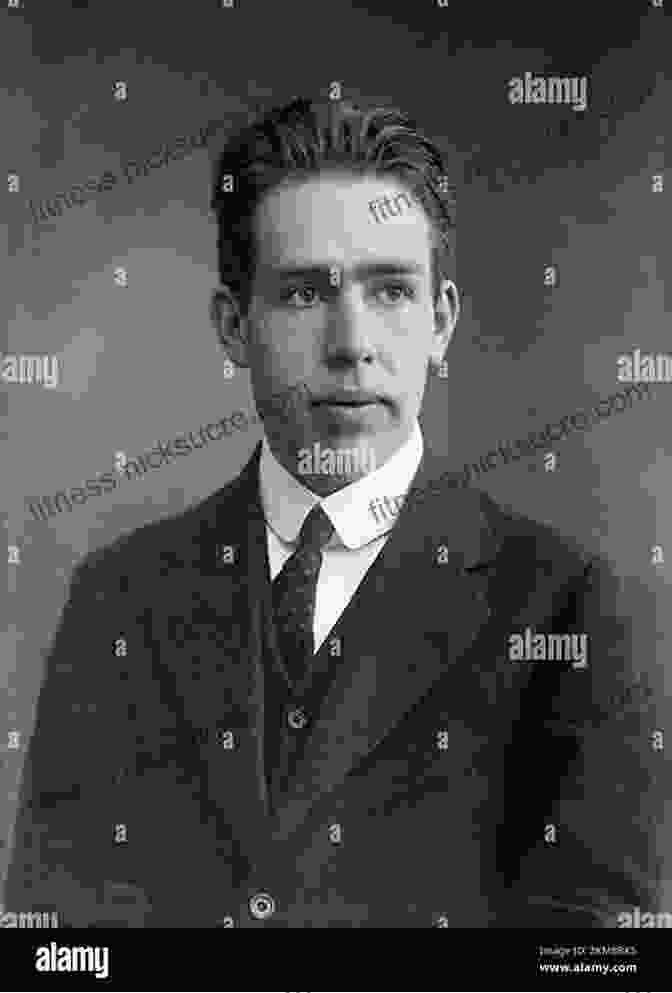
Niels Bohr was a Danish physicist who made significant contributions to the development of quantum mechanics. His model of the atom, which introduced the concept of energy levels and quantum transitions, revolutionized our understanding of the structure of matter.
Bohr was born in Copenhagen, Denmark, in 1885. He studied physics at the University of Copenhagen, where he was a student of Christian Christiansen. After graduating, Bohr worked in England with J.J. Thomson and Ernest Rutherford. In 1913, he returned to Copenhagen and became a professor at the University of Copenhagen.
Bohr's model of the atom was published in 1913. The model proposed that electrons orbit the nucleus in discrete energy levels. When an electron transitions from one energy level to another, it emits or absorbs a photon of light. Bohr's model was a major breakthrough in the understanding of the structure of matter and laid the foundation for the development of quantum mechanics.
Bohr was also a prominent advocate for the peaceful use of nuclear energy. He was a member of the Atomic Energy Commission of the United Nations from 1948 to 1954. Bohr died in Copenhagen in 1962.
Erwin Schrödinger (1887-1961): The Father of Wave Mechanics

Erwin Schrödinger was an Austrian physicist who made significant contributions to the development of quantum mechanics. His wave equation, which describes the wave-like properties of particles, is one of the most important equations in physics.
Schrödinger was born in Vienna, Austria, in 1887
4.3 out of 5
| Language | : | English |
| File size | : | 2881 KB |
| Text-to-Speech | : | Enabled |
| Screen Reader | : | Supported |
| Enhanced typesetting | : | Enabled |
| Word Wise | : | Enabled |
| Print length | : | 500 pages |
Do you want to contribute by writing guest posts on this blog?
Please contact us and send us a resume of previous articles that you have written.
 Fiction
Fiction Non Fiction
Non Fiction Romance
Romance Mystery
Mystery Thriller
Thriller SciFi
SciFi Fantasy
Fantasy Horror
Horror Biography
Biography Selfhelp
Selfhelp Business
Business History
History Classics
Classics Poetry
Poetry Childrens
Childrens Young Adult
Young Adult Educational
Educational Cooking
Cooking Travel
Travel Lifestyle
Lifestyle Spirituality
Spirituality Health
Health Fitness
Fitness Technology
Technology Science
Science Arts
Arts Crafts
Crafts DIY
DIY Gardening
Gardening Petcare
Petcare Said Hasyim
Said Hasyim Alice Roberts
Alice Roberts Rev Cain
Rev Cain Sam Thoma
Sam Thoma John F Gilbey
John F Gilbey Aris Spanos
Aris Spanos Susan Jules
Susan Jules Matthew Bowling
Matthew Bowling Larry Baush
Larry Baush Zar Petkov
Zar Petkov Alexia Leachman
Alexia Leachman Frank C Hawkins
Frank C Hawkins Michelle Rotteau
Michelle Rotteau Udo Schaefer
Udo Schaefer Daniel Young
Daniel Young Karin Perry
Karin Perry Scott Chimileski
Scott Chimileski Duncan Hines
Duncan Hines M Mitchell Waldrop
M Mitchell Waldrop Dr Heather L Johnson
Dr Heather L Johnson Penny Warner
Penny Warner Dean Pohlman
Dean Pohlman George S Fichter
George S Fichter Wade Davis
Wade Davis Rails To Trails Conservancy
Rails To Trails Conservancy Lonely Planet
Lonely Planet Alice Kuipers
Alice Kuipers Martha Shirk
Martha Shirk Jonny Bowden
Jonny Bowden Eric Siegel
Eric Siegel Shaun David Hutchinson
Shaun David Hutchinson Richard H Coop
Richard H Coop Brigid Moss
Brigid Moss Malala Yousafzai
Malala Yousafzai Joe Dolio
Joe Dolio Ian Morris
Ian Morris Kathleen Mcauliffe
Kathleen Mcauliffe John Madieu
John Madieu Alice Gorman
Alice Gorman Peter J Hotez
Peter J Hotez Heather Lang
Heather Lang Daniel Goleman
Daniel Goleman Jermaine Harris
Jermaine Harris Gary Wayne
Gary Wayne Emily Levesque
Emily Levesque Ken Mink
Ken Mink Gary A Klein
Gary A Klein Jack Batten
Jack Batten Lara Carter
Lara Carter Tracy Anderson
Tracy Anderson Arthur Lydiard
Arthur Lydiard Jay Golden
Jay Golden Donna Bozzo
Donna Bozzo Frank White
Frank White Joeanna Rebello Fernandes
Joeanna Rebello Fernandes Paul Wilmott
Paul Wilmott Paul Green
Paul Green Erica Lyon
Erica Lyon Stuart Kauffman
Stuart Kauffman Tracy Becker
Tracy Becker Grackle Pigeon
Grackle Pigeon Gabriel Aluisy
Gabriel Aluisy Andy Kirkpatrick
Andy Kirkpatrick Susan Wise Bauer
Susan Wise Bauer Alexis C Bunten
Alexis C Bunten Alexandra Brodsky
Alexandra Brodsky Kevin Allen
Kevin Allen Nick Kalyn
Nick Kalyn Mary Johnson
Mary Johnson Shaka Senghor
Shaka Senghor Yehuda Lindell
Yehuda Lindell Deborah Layton
Deborah Layton Jay Greenberg
Jay Greenberg Kirstin Cronn Mills
Kirstin Cronn Mills Heidi Murkoff
Heidi Murkoff Steve O Hearn
Steve O Hearn Alexandra M Levitt
Alexandra M Levitt John G West
John G West Robert Scott
Robert Scott Malina Malkani Ms Rdn Cdn
Malina Malkani Ms Rdn Cdn Anna Mathur
Anna Mathur Leslie Berlin
Leslie Berlin Constantine A Balanis
Constantine A Balanis Jen Noonan
Jen Noonan Norman L Keltner
Norman L Keltner Tim Maudlin
Tim Maudlin Eric Barker
Eric Barker Alice Steinbach
Alice Steinbach Keisuke Andrew
Keisuke Andrew Ali Velez Alderfer
Ali Velez Alderfer Romina Garber
Romina Garber Alexei Yurchak
Alexei Yurchak David G Kingdon
David G Kingdon John Abramson
John Abramson Mark Kaplan
Mark Kaplan Karin Bojs
Karin Bojs Penny Armstrong
Penny Armstrong Li Ming Lee
Li Ming Lee Penelope Freed
Penelope Freed Karen Mcquestion
Karen Mcquestion Hicham And Mohamed Ibnalkadi
Hicham And Mohamed Ibnalkadi Alice Nobile
Alice Nobile Doc Norton
Doc Norton Lisa Manterfield
Lisa Manterfield Louis Borgenicht
Louis Borgenicht David A Ebert
David A Ebert Scott Linden
Scott Linden Laura Gauld
Laura Gauld Joshua R Eyler
Joshua R Eyler Alfie Kohn
Alfie Kohn Lydia Wylie Kellermann
Lydia Wylie Kellermann Alice June
Alice June Roland Huntford
Roland Huntford Mark Elbroch
Mark Elbroch Andrew Zimmern
Andrew Zimmern Darrin Gee
Darrin Gee Roy Barth
Roy Barth Dylan Farrow
Dylan Farrow John Pirillo
John Pirillo Lola Glass
Lola Glass Michele Filgate
Michele Filgate Peter Gandy
Peter Gandy Matthew Dektas
Matthew Dektas Allison Saft
Allison Saft Margaret Starbird
Margaret Starbird Chase Kosterlitz
Chase Kosterlitz Helen Hodgson
Helen Hodgson Kathryn A Bard
Kathryn A Bard Adrian Dingle
Adrian Dingle Neil J Salkind
Neil J Salkind Wayne Stewart
Wayne Stewart Charles Hainsworth
Charles Hainsworth Executivegrowth Summaries
Executivegrowth Summaries Bayo Akomolafe
Bayo Akomolafe Alexis Marie Chute
Alexis Marie Chute Arthur Ashe
Arthur Ashe Pantea Kalhor
Pantea Kalhor Thao Doan
Thao Doan Gordon England
Gordon England Suzy Amis Cameron
Suzy Amis Cameron Alice Scordato
Alice Scordato Wendy Wood
Wendy Wood Nick Mitchell
Nick Mitchell Carmindy
Carmindy Stacy Tornio
Stacy Tornio Alice Borchardt
Alice Borchardt Carol Ekarius
Carol Ekarius Robert Zimmerman
Robert Zimmerman Helen Purperhart
Helen Purperhart Erez Morabia
Erez Morabia David Maidment
David Maidment Ruby Vincent
Ruby Vincent Lance Akiyama
Lance Akiyama Eleanor Drago Severson
Eleanor Drago Severson Kathy Barker
Kathy Barker Lauren Harris
Lauren Harris Melia Keeton Digby
Melia Keeton Digby Laura Katz
Laura Katz Milly Buonanno
Milly Buonanno Martha Sears
Martha Sears Robin G Jordan
Robin G Jordan Carmen Martinez Jover
Carmen Martinez Jover Lara Alcock
Lara Alcock Sharon Powell
Sharon Powell Josh Peter
Josh Peter Luke Reynolds
Luke Reynolds Mary Cholmondeley
Mary Cholmondeley Robert L Kelly
Robert L Kelly Alice Boyes Ph D
Alice Boyes Ph D Lauren Drain
Lauren Drain Michael Mcteigue
Michael Mcteigue Alice Jolly
Alice Jolly Penelope Leach
Penelope Leach David Armitage
David Armitage Seabury Blair
Seabury Blair Alina Adams
Alina Adams Alice Beck Kehoe
Alice Beck Kehoe Jane Gildart
Jane Gildart Joshua Coleman Phd
Joshua Coleman Phd Jessica Long
Jessica Long Ellen Kane
Ellen Kane Steven Pressfield
Steven Pressfield Alexis L Boylan
Alexis L Boylan Ryuu Shinohara
Ryuu Shinohara Michaelbrent Collings
Michaelbrent Collings Thomas Horn
Thomas Horn Tom Mackie
Tom Mackie Alfred Tennyson
Alfred Tennyson Elan Golomb
Elan Golomb Joe Proulx
Joe Proulx Alice Miller
Alice Miller Elizabeth Clare Prophet
Elizabeth Clare Prophet Alexandra Bracken
Alexandra Bracken Nick Littlehales
Nick Littlehales Jeff Cooper
Jeff Cooper Whitney Ferre
Whitney Ferre Dustin Vaughn Warncke
Dustin Vaughn Warncke Randy Spencer
Randy Spencer Sigurd F Olson
Sigurd F Olson Glade B Curtis
Glade B Curtis Clay Bonnyman Evans
Clay Bonnyman Evans Kynan Bridges
Kynan Bridges Veronica O Keane
Veronica O Keane Alexia Purdy
Alexia Purdy Alexandra Kennon
Alexandra Kennon Peter Woit
Peter Woit Complete Test Preparation Inc
Complete Test Preparation Inc Patricia A Mckillip
Patricia A Mckillip Rosary O Neill
Rosary O Neill Erika Rogers Holland
Erika Rogers Holland Alice Cooper
Alice Cooper Mark Harris
Mark Harris Anymom
Anymom Alexandra Fuller
Alexandra Fuller Jonathan Weiner
Jonathan Weiner Judith Levin
Judith Levin Sammy Hagar
Sammy Hagar Robert P Crease
Robert P Crease Alexandria Moran
Alexandria Moran Corky Pollan
Corky Pollan Robert Lusetich
Robert Lusetich Alice Walker
Alice Walker Peter D Rogers
Peter D Rogers Judy Murray
Judy Murray Heather Baker
Heather Baker Ernie Palladino
Ernie Palladino Heinrich Cornelius Agrippa Von Nettesheim
Heinrich Cornelius Agrippa Von Nettesheim Michael Thorp
Michael Thorp Jerry Lynch
Jerry Lynch Philip Rossoni
Philip Rossoni Richard Moore
Richard Moore Douglas Starr
Douglas Starr Alice Sebold
Alice Sebold Mario Cleves
Mario Cleves Michael R Lindeburg
Michael R Lindeburg Sarah Melland
Sarah Melland Vicki Manning
Vicki Manning Sarah Bolitho
Sarah Bolitho Anders Morley
Anders Morley Michael Vlessides
Michael Vlessides Jayson Georges
Jayson Georges Pam Withers
Pam Withers Sarah Rayner
Sarah Rayner Carolyn Highland
Carolyn Highland John C Hudson
John C Hudson Rachel Vitale
Rachel Vitale Thomas F King
Thomas F King Ally Nathaniel
Ally Nathaniel Tim R Swartz
Tim R Swartz William King
William King Ted Zeff
Ted Zeff Mikel Jollett
Mikel Jollett Zac Unger
Zac Unger Amy Pickar Abernethy
Amy Pickar Abernethy John Bemelmans Marciano
John Bemelmans Marciano Eric Kaplan
Eric Kaplan Sue Tidwell
Sue Tidwell Alfred Tarski
Alfred Tarski Ashley Mardell
Ashley Mardell Les Adams
Les Adams Patrick Ness
Patrick Ness Guy Hunter Watts
Guy Hunter Watts Mary Kay Andrews
Mary Kay Andrews Amanda Ripley
Amanda Ripley Alexis Averbuck
Alexis Averbuck Ali Katz
Ali Katz Dan Jenkins
Dan Jenkins Charles Murray
Charles Murray Kev Reynolds
Kev Reynolds Paige Wolf
Paige Wolf Thomas Hill
Thomas Hill Bjorn Kjellstrom
Bjorn Kjellstrom Chip K
Chip K Lawrence Weschler
Lawrence Weschler Alicia Ranoldo
Alicia Ranoldo David J Goldman
David J Goldman Karl Wiegers
Karl Wiegers Howard Pyle
Howard Pyle Bear Grylls
Bear Grylls Eileen Edna Power
Eileen Edna Power Nancy Carpentier Brown
Nancy Carpentier Brown Robert Kagan
Robert Kagan Andrew Yueh
Andrew Yueh David Gessner
David Gessner David Byrne
David Byrne Alfred Edersheim
Alfred Edersheim Jeremy Hance
Jeremy Hance Brian D Ambrosio
Brian D Ambrosio Arthur Robert Harding
Arthur Robert Harding Alexandra Mayzler
Alexandra Mayzler Jenna Ortega
Jenna Ortega Robert A Monroe
Robert A Monroe Sir Oliver Lodge
Sir Oliver Lodge Lynne Robinson
Lynne Robinson Courtney Kenney
Courtney Kenney Jessica Goodman
Jessica Goodman David R Hawkins
David R Hawkins C S Johnson
C S Johnson Melissa Falkowski
Melissa Falkowski Paul Stephenson
Paul Stephenson Robin Kaplan M Ed Ibclc
Robin Kaplan M Ed Ibclc Pottermore Publishing
Pottermore Publishing Katie Walsh Flanagan
Katie Walsh Flanagan Dagny Scott Barrios
Dagny Scott Barrios Stacey L Bradford
Stacey L Bradford Carlton Kirby
Carlton Kirby Adah Bakalinsky
Adah Bakalinsky Steve Parker
Steve Parker Vishal Sambharya
Vishal Sambharya Shannon Messenger
Shannon Messenger Emily Riehl
Emily Riehl Dr C
Dr C Richard Preston
Richard Preston Jean Chatzky
Jean Chatzky Nic Sheff
Nic Sheff Sarah K L Wilson
Sarah K L Wilson Carol Chaitkin
Carol Chaitkin Jose Albani
Jose Albani Normandi Ellis
Normandi Ellis Frank J Tipler
Frank J Tipler Jonathan Carroll
Jonathan Carroll Michael J Behe
Michael J Behe Matilda Betham
Matilda Betham Lynne Cox
Lynne Cox Matthew Silverman
Matthew Silverman Lyanda Lynn Haupt
Lyanda Lynn Haupt Craig S Brantley
Craig S Brantley Dan Aadland
Dan Aadland Jon Moxley
Jon Moxley David Travis
David Travis David J Rothman
David J Rothman Karin Slaughter
Karin Slaughter Ali Wong
Ali Wong Peter Collier
Peter Collier Daniel M Davis
Daniel M Davis Ron Ritchhart
Ron Ritchhart Mike Westin
Mike Westin Suzanne Giesemann
Suzanne Giesemann K T Hanna
K T Hanna Mark Rippetoe
Mark Rippetoe Mike Wallace
Mike Wallace Patti M Hummel
Patti M Hummel Ben Applebaum
Ben Applebaum Alicia Puglionesi
Alicia Puglionesi Beccy Hands
Beccy Hands Aram Attarian
Aram Attarian Joel Weinberger
Joel Weinberger Tasha Alexander
Tasha Alexander Crystal Waltman
Crystal Waltman Jodi L Weinstein
Jodi L Weinstein Ali Almossawi
Ali Almossawi William G Tapply
William G Tapply Stephanie Mitchell Cnm Msn Dnp
Stephanie Mitchell Cnm Msn Dnp Hape Kerkeling
Hape Kerkeling Peter Stark
Peter Stark Raymond Barrett
Raymond Barrett Alfred Lambremont Webre
Alfred Lambremont Webre Neil Schulenburg
Neil Schulenburg Gen Tanabe
Gen Tanabe Ali Novak
Ali Novak Becca Maberly
Becca Maberly German Raigosa
German Raigosa Tim Weston
Tim Weston Dawn Brookes
Dawn Brookes Susan Albers
Susan Albers Dianna L Van Blerkom
Dianna L Van Blerkom Christopher Mitchell
Christopher Mitchell Michael Johnson
Michael Johnson Joy S Kasson
Joy S Kasson Terry Marsh
Terry Marsh Carl Erskine
Carl Erskine Bernie Clark
Bernie Clark Patrick Torsell
Patrick Torsell Jim Mclean
Jim Mclean John Pagano
John Pagano David Wolman
David Wolman Daniel Foor Phd
Daniel Foor Phd Paul H Frampton
Paul H Frampton Mary Beth Knight
Mary Beth Knight Nancy Roe Pimm
Nancy Roe Pimm Thomas Hund
Thomas Hund Deborah Laird Meeks
Deborah Laird Meeks Oivind Andersson
Oivind Andersson Kenn Bivins
Kenn Bivins Kimberly V Garner
Kimberly V Garner Rebecca Schwarzlose
Rebecca Schwarzlose Leslie Anthony
Leslie Anthony George Takei
George Takei Natalie Angier
Natalie Angier Rob Price
Rob Price Ryan Guldberg
Ryan Guldberg Nora Roberts
Nora Roberts Jeff Sambur
Jeff Sambur Valora Conciencia En Los Medios
Valora Conciencia En Los Medios David Watson
David Watson Theodore Roosevelt
Theodore Roosevelt Hollie Henderson
Hollie Henderson Frank Amthor
Frank Amthor Jeremy Benson
Jeremy Benson Karyl Rickard
Karyl Rickard Michael Cave
Michael Cave Eric Layton
Eric Layton Scott Weems
Scott Weems Arno Ilgner
Arno Ilgner Minda Harts
Minda Harts Sabina Khan
Sabina Khan Anthony Legins
Anthony Legins Yvette Marquez Sharpnack
Yvette Marquez Sharpnack Alexey Osadchuk
Alexey Osadchuk Alexandra Robbins
Alexandra Robbins Stephen Altschuler
Stephen Altschuler Diana Hudson
Diana Hudson Krissy Moehl
Krissy Moehl Devyn Stone
Devyn Stone Bassem R Mahafza
Bassem R Mahafza John Lohn
John Lohn Mark Sisson
Mark Sisson Mike Commito
Mike Commito America S Test Kitchen
America S Test Kitchen Joseph Henrich
Joseph Henrich Sarah A Chrisman
Sarah A Chrisman Alexandra Heminsley
Alexandra Heminsley Reina Donovan
Reina Donovan Wendy Currie
Wendy Currie Eric Mantle
Eric Mantle Lindsay Grace
Lindsay Grace Sacha Black
Sacha Black Mitchell P Jones
Mitchell P Jones Michael Patrick Ghiglieri
Michael Patrick Ghiglieri David A Askay
David A Askay Crysta Mchenry
Crysta Mchenry Jessica Riskin
Jessica Riskin Mark C Purcell
Mark C Purcell Jill Simonian
Jill Simonian Brent Warner
Brent Warner Michael Vassallo
Michael Vassallo David G Alciatore
David G Alciatore Michael Clark
Michael Clark Jim Vance
Jim Vance Hank D Haney
Hank D Haney George Beinhorn
George Beinhorn Alexey Zimarev
Alexey Zimarev Kathy Gunst
Kathy Gunst Jim Walden
Jim Walden Alice Horton
Alice Horton Alfred North Whitehead
Alfred North Whitehead Karen Kovacs
Karen Kovacs Phillip Starr
Phillip Starr Sir E A Wallis Budge
Sir E A Wallis Budge Matthew Cowsert
Matthew Cowsert Jason Selk
Jason Selk Nel Noddings
Nel Noddings Whitney Miller
Whitney Miller G Pascal Zachary
G Pascal Zachary Mike Dauplaise
Mike Dauplaise Mark Zondo
Mark Zondo Roddy Scheer
Roddy Scheer Damon Centola
Damon Centola Bob Toski
Bob Toski Christopher Steiner
Christopher Steiner Hans Rosling
Hans Rosling Avi Gordon
Avi Gordon Peter Flom
Peter Flom Emma Lock
Emma Lock Henry Gilbert
Henry Gilbert Samantha Cattach
Samantha Cattach Virgil Herring
Virgil Herring Philip Freeman
Philip Freeman Stephen Ilg
Stephen Ilg Charlie N Holmberg
Charlie N Holmberg Stephen Blyth
Stephen Blyth Alfred Begum
Alfred Begum Paul Asay
Paul Asay Frederick Courteney Selous
Frederick Courteney Selous Peggy Vincent
Peggy Vincent Rin Chupeco
Rin Chupeco
Light bulbAdvertise smarter! Our strategic ad space ensures maximum exposure. Reserve your spot today!
 Jeremy MitchellThe Story of the Iconic Hockey Club and Its Top 50 Heroes: Wins, Events, and...
Jeremy MitchellThe Story of the Iconic Hockey Club and Its Top 50 Heroes: Wins, Events, and... Allen ParkerFollow ·17.5k
Allen ParkerFollow ·17.5k Ricky BellFollow ·7.1k
Ricky BellFollow ·7.1k Manuel ButlerFollow ·9.7k
Manuel ButlerFollow ·9.7k Gustavo CoxFollow ·14.8k
Gustavo CoxFollow ·14.8k Simon MitchellFollow ·8.9k
Simon MitchellFollow ·8.9k Pablo NerudaFollow ·15.3k
Pablo NerudaFollow ·15.3k Derek CookFollow ·5.5k
Derek CookFollow ·5.5k Guy PowellFollow ·15.1k
Guy PowellFollow ·15.1k

 Derek Bell
Derek BellReflections For Your Heart and Soul: A Journey of...
In the depths of...

 Joseph Conrad
Joseph ConradThe Heroines Club: Empowering Mothers and Daughters
The Heroines Club...

 Milan Kundera
Milan KunderaThe First Kormak Omnibus: A Literary Expedition into the...
Prepare to embark on an extraordinary literary...

 W.H. Auden
W.H. AudenThe Color Purple: A Journey of Love, Resilience, and...
The Color Purple, a groundbreaking novel...

 Harvey Hughes
Harvey HughesTemporal Anomalies and Replacement Theory: Unraveling the...
: The Enigma of Time Time,...
4.3 out of 5
| Language | : | English |
| File size | : | 2881 KB |
| Text-to-Speech | : | Enabled |
| Screen Reader | : | Supported |
| Enhanced typesetting | : | Enabled |
| Word Wise | : | Enabled |
| Print length | : | 500 pages |


